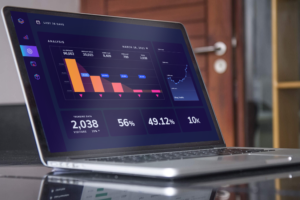If you are researching or considering real-time reporting for your contact center, you are ahead of the curve, maybe even a visionary.
Take a look back at the history of communication, and you discover that the trend has been to go from manual processes to automated ones, and from analog processes to digital ones. Writing letters on paper was replaced by writing email messages on a screen. Manual switchboards were replaced by digital, omnichannel contact centers. And periodic, manual reporting by supervisors with clipboards gave way to automatic, real-time reporting by bots and dashboards.
 And this brings us to today’s contact centers, which are poised for a major transformation when it comes to reporting. Why? Because monitoring and reporting are not keeping up with the demands of customers and the demands of business.
And this brings us to today’s contact centers, which are poised for a major transformation when it comes to reporting. Why? Because monitoring and reporting are not keeping up with the demands of customers and the demands of business.
One of the major problems faced by managers and staff tasked with reporting in contemporary contact centers is data silos. Live Chat apps store their data in one place, the folks in Phone Support store their data in another place, and other channels store their data in yet another place. The result is that customers never have a seamless and cohesive experience. They must re-introduce themselves and re-describe their issue with every channel they use. Data silos create frustrated customers and users.
Then there is the challenge of multiple, outdated tools, including a mix of apps and spreadsheets and plenty of manual data entry. Unfortunately, this leads to staff wasting a great deal of time and energy just to produce the simplest and most routine reports.
But the fundamental problem with reporting in call centers today is that the data being gathered and analyzed is all historical data. It’s hours old, or days. This means managers and executives never have the latest data at their disposal. Which means the insights that they gain and the courses of action they take are always based on out-of-date data.
The Future is Real-Time
The future of contact center management is real-time: real-time monitoring, real-time analytics, and real-time reporting. Monitoring gathers the data and reporting displays the data.
Real-time monitoring uses devices, software applications, and tools to track the performance of your contact center. The process involves gathering data at the exact time that events occur and then making that data available within milliseconds (in other words, virtually immediately).
Real-time analytics leverages the power of real-time call center metrics to create a more efficient and effective contact center experience for your customers. You eliminate data silos and create contact center agility. Also reducing wasted workforce labor and optimize call routing with real-time call and queue metrics that give a complete view of your call center operations.
Real-time reporting involves three steps: aggregation, normalization, and visualization. First gathering data from multiple, isolated systems and softwares, such as interactive voice response (IVR), customer relationship management (CRM), and workforce management (WFM), and aggregates it in one place. It then normalizes that data so that nomenclatures and naming conventions are consistent. Finally, it displays that data on a simplified interface, typically a real-time dashboard that is viewed through a web browser.
Monitoring, analytics, and reporting must all work together to provide the complete picture. Monitoring gathers the data. Analytics makes sense of the data. And reporting presents that data for you to act upon.
Visualizing Your Performance
An effective real-time reporting system for your contact center does more than just present raw numbers, though. It also analyzes your data before displaying it so that you gain real-time insights into your performance.
For example, the system tracks and analyzes performance across sites, functions, levels, and agents so that you can monitor performance at a glance at a moment’s notice. It tracks your current Average Waiting Time, and compares it with historical data (same time and day last week, last month or last year, for example) so that you see if you are operating at, above or below historical norms and targets.
Your contact center real-time reporting system can track what you need it to track, including:
- First Contact Resolution (FCR). A metric that measures a contact center agent’s ability to resolve a customer’s inquiry or problem on the first call or contact. A low score can increase costs, while a high score can enhance revenue.
- Speed of Answer. Measures agent timelines. Typically measured in seconds. The lower the number the number (in other words, the shorter the delay in answering), the better.
- Average Resolution Time. The time it takes your team to bring a submission to a resolution. Can be measured in minutes, hours or days. Naturally, the shorter the better. But since not all issues are the same, you are wise to parse your Average Resolution Times by ticket type.
- Average Call Handling Time. The entire length of time required to resolve a customer issue, from the moment a customer places the call to the time that the customer hangs up. Includes all time spent on hold and all transfer times.
- Average Time in Queue. The average length of time callers spend waiting to be connected to an agent. Typically varies by time of day, time of year, and channel.
- Call Volume. The number of calls received in a given time period, such as one hour or one day, or a time of the year.
- Call Quality. A subjective metric that indicates the level of effectiveness and efficiency achieved during a call. Includes such qualities as politeness, professionalism and empathy agents offer during their interaction with customers.
- Idle Time (Agent Utilization). The length of time that an agent spends between calls being unproductive.. In other words, the amount of time that transpires from the time that an agent indicates that the agent is ready to answer calls, to the time that the agent answers a call. Not to be confused with the time that an agent is not on a call but is being productive, such as conducting after-call wrap activities.
- Agent performance. Combine these metrics above and apply them to each agent, and you build a quick picture of agent performance. Use this metric across sites, across tiers, and across agents to spot patterns, problems and areas for improvement.
It’s important to remember that these metrics will only work best when tracked with the right technology that can provide customizable views needed for your contact center’s specific needs. For example, consider an analytics system that provides an omnichannel view of customer data with highly customizable dashboards. Doing so will allow you to gain visibility into all consumer touch points, meet your customers in the right channels, and streamline communication for personalized experiences.
Benefits of Contact Center Real-Time Reporting
Going from analog to digital, from manual to automated, and from historical to real-time reporting has its benefits. Your move to real-time reporting is all about boosting your contact center efficiency and insights.
Benefit 1: Optimize Contact Center Operations
Real-time monitoring and reporting optimizes your contact center operations by giving your team a broad, holistic view of your contact center. It gathers all data from all sources and channels and consolidates it in one place so that you gain a 360° view of your operations.
Gathering and displaying your contact center metrics in real-time helps your managers make informed decisions based on comprehensive, real-time data. If there have been sudden changes to a project, for example, your dashboards will show you the impact of these changes as they are impacting your contact center at that very moment. You will be armed with the insights you need to change and improve things to accommodate these sudden changes.
As you can appreciate by now, real-time reporting gives your managers quick access to agent-customer interactions as they are happening. Since there is no time like the present when managing and operating your contact center, having access to this data as things are unfolding means the difference between acting now versus acting later. In other words, resolving an issue while the customer is still on the phone, instead of waiting until the customer has hung up to address their issue.
Benefit 2: Improve Customer Experience
The primary benefit of real-time performance metrics is that they help agents improve service quality and the customer experience while they still have the customer on the phone. That’s because a predictable thing happens when you put agent-performance metrics in front of agents in real-time—they up their game to meet the standards you are setting for them.
In the past, agents had to wait for a performance appraisal meeting with their manager or reporting staff to discover if their performance met company expectations. With a real-time reporting system, they see at a glance how they are doing at that exact moment. They can immediately view and analyze how their First-Call Resolution Rate compares with the company standard, for example. They see if their Average Call Handling Time is better than or worse than that of other agents who are working that same shift.
Real-time reporting not only generates real-time improvements in agents’ quality of work and work performance. It also helps enhance company supervisors and managers determine the training that’s needed for agents to improve or if additional staff needs to be hired to accommodate increased work. And it gives your company a practical, immediate way of ensuring compliance throughout the operation.
Benefit 3: Cross-sell and Up-sell
If you want your contact center agents to seize upon opportunities to cross-sell and up-sell, you must give them the data they need—when they need it. With real-time reporting dashboards, you can prompt agents to offer a better version of the product that a customer is ready to purchase at a higher price. Real-time reporting also helps you as a company discover new revenue opportunities that you might not be able to see with traditional reporting.
You can expect that this process will require extensive trial and error to settle into the most effective of offering strategies. Additionally, your contact center agents or call center customer service representatives may benefit from specialized training so that conversations that become opportunities for upselling will flow more naturally. Once the process does feel more organic or instinctive for internal team members, the rewards will be in obtaining higher levels of success in close rates or average order sales.
Benefit 4: Optimize Your Work Queue
The fourth benefit of contact center real-time reporting is improved work queue efficiency. When you have your current Average Time in Queue metric displayed on a dashboard in front of you, you are suddenly in a position to do something about it. The same goes for Average Waiting Times and Speed of Answer.
When you can see what your work queue looks like right at that very moment, you can take steps to optimize call routing, reassign agents and maximize agent performance. Real-time reporting helps you keep your agents busy and productive. And it also helps to reduce wasted workforce labor your agents might be spending on trying to improve their efficiency with traditional insights.
Call Monitoring Best Practices
Someone once said that if you want to manage it, measure it. But the reverse is also true. If you have measured it, manage it. Or, to put things another way, don’t spend your time just measuring it if you can’t plan on managing it. The whole point of measuring, analyzing, and reporting on your contact center data is to act upon it. Here are some best managing and measuring practices to implement based on your metrics.
Go Beyond The Metrics
Look for the meaning behind your metrics. If your Average Call Handling Time has increased, for example, don’t assume this is simply a bad thing. Don’t look to your agents alone to find blame. After all, you may be experiencing longer Average Call Handling Times because you are rolling out a new product. Adoption rates have gone through the roof, putting strain on your agents to resolve issues as quickly as before.
Going beyond the metrics requires looking at a complete picture of your operations, time of year, competitive environment, and more to give the metrics the proper context to make intelligent, data-driven decisions.
Hold Retro Meetings With Your Team
In an agile environment, team retrospectives are held to take a look back on best practices or winning behaviors that are deemed successful. These successes seen in your call center environment could then be implemented to maximize productivity and efficiency.
For example, a retro meeting could allow your top-performing agents the opportunity to share what tactics and languages have enabled them to resolve calls more quickly or ensure a higher quality of customer service. You may even find that this behavior reinforces a positive workplace culture that celebrates and shares the wins of employees and holds agents accountable for their goals.
This is also a time where employees can communicate any setbacks or frustrations they are encountering and could use advice on. For example, if one of your agents is struggling with their closing messaging, this is the time higher performing agents can offer feedback that can be helpful. Remember, this is a safe place for constructive criticism and celebration. This is not the meeting for employees to point fingers or blame others for not meeting standards.
Benchmark External Data And Statistics
One of the greatest advantages of gathering, analyzing, and reporting on real-time data is that you can compare it with external industry benchmarks to see how your contact center is performing in actual time and review realistic targets for your overall performance.
Start by gathering industry benchmarks for the key performance indicators (KPIs) that you want to monitor. Document these benchmarks, and then add a column beside each benchmark to display your own benchmark. Then use your real-time reporting software to tell you when you fall below, meet or exceed industry benchmarks.
Reward Top Performers
If you want to find an objective way to reward agents who outperform other agents, start with your real-time reporting tool. It shows you in full color the agents who are exceeding your targets for first-call resolution, call quality, and more.
Metrics give all of your agents a standard to reach, and a performance level to exceed. They also level the playing field by eliminating bias.
Document Your Call Monitoring Policy
One of your goals in operating your contact center is to eliminate surprises. That means no surprises with callers, but also no surprises with agents. One way to eliminate surprises is to document your call monitoring policy.
Get your entire team on board by spelling what you measure, how you measure, and why. Then, describe how real-time monitoring, analytics, and reporting helps your organization deliver a better customer experience and helps your agents work more efficiently.
What a Modern Contact Center Looks Like
 Just as switchboard operators have been replaced by software, and just as manual data gathering has been replaced by automated systems, so, too, is the old contact center being replaced by the modern contact center. Here are the top features of today’s contact centers.
Just as switchboard operators have been replaced by software, and just as manual data gathering has been replaced by automated systems, so, too, is the old contact center being replaced by the modern contact center. Here are the top features of today’s contact centers.
Centralized. All data from all disparate systems is consolidated into one application for analysis and reporting. Data silos are out. Integration is in.
Real-time. Data is gathered, analyzed, and displayed almost immediately, giving an accurate picture of how a contact center is performing in the present.
Dashboards. Data is displayed in real-time dashboards that show customer touchpoints in their preferred channels. These dashboards give contextual data that helps contact centers provide a more personalized customer experience.
Omnichannel. Data is integrated across all channels so that the contact center delivers a seamless, omnichannel experience to customers.
Automated. Cumbersome, time-consuming, manual methods of extracting data and consolidating it using spreadsheets and different reporting tools are replaced by automation.
Conclusion
The future of contact center operations is real-time reporting. Real-time data will be the fuel needed to propel your contact center while enabling you to be future-proof. Monitoring your data as events unfold gives you the leverage you need to grow your business. Real-time monitoring gives you the data insights you need when you need them to improve service quality and adjust your strategy on the fly. Knowing what happens when it happens provides the level of information necessary to optimize the customer experience.
Real-time reporting also helps you uncover hidden patterns and unknown correlations. The insights you gain inform your future business strategies. And that means greater profitability and improved efficiency.
Having real-time, actionable insights about your contact center data in a centralized, flexible dashboard is possible. Have you considered what this level of visibility could mean for the success of your business?
Choosing a tool for real-time contact center monitoring
As you have seen, real-time contact center monitoring requires three steps: gathering, analyzing, and reporting. Most often, to do all three, you need one or more tools. It can be difficult to even decipher where to begin when choosing a new data reporting platform in a world with many options. The first step to making this decision is to understand what reporting features are essential for your team in the first place. Is it important to have a platform that brings your data sources together? Or is it more important for a platform to improve the employee experience? Or is it important to do both?
Call analytics software calculates your performance based on key metrics, such as Average Call Handling Time and Average Time in Queue.
Contact center monitoring and data visualization software displays your performance. It organizes your data so that you easily see and make sense of what’s happening. This gives you guidance into adjustments you must make to improve efficiency.
The good news is that the solutions from Aceyus can be an all-in-one, integrated solution for your organization. We give you the tools needed to easily access your contact center metrics and centralize your data into a single, real-time dashboard. With reporting dashboards for companies of all sizes, we’ve got the solutions you need to empower your team with smart data and give you the competitive edge needed to increase your bottom line.
Through data integrations and standardization, Aceyus easily adapts to the constant changes of customer interactions resulting in higher productivity and customer satisfaction. We are well-equipped to empower you to improve customer experiences by giving you the tools you need to pull real-time, actionable insights from your contact-center data. Getting started starts with a conversation. Let’s book a time for a product demo.



